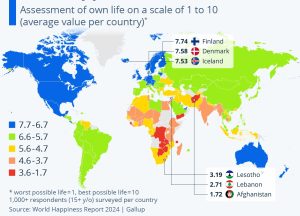In 2012, the United Nations proclaimed March 20 as the International Day of Happiness or World Happiness Day, which has been held on this date every year since.
The aim is to promote awareness for a “more inclusive, equitable and balanced approach to economic growth that promotes the happiness and well-being of all people”.
Although happiness and satisfaction are subjective parameters, the team behind the World Happiness Report has once again produced a country ranking this year that reveals clear differences between Western industrialized nations and countries in Asia and Africa.
World Happiness Day aims to promote awareness for a more inclusive, equitable and balanced approach to economic growth that promotes the happiness and well-being of all people
In order to map the satisfaction of respondents in the 143 countries surveyed, participants were asked to rate their level of satisfaction with their current life on a 10-point scale. This was used to calculate an average value for the results between 2021 and 2023 for each country.
 As this chart, based on the report shows, Finland (7.74), Denmark (7.58) and Iceland (7.53) are the countries with the most satisfied residents according to calculations, while the three lowest scores are found among the residents of Lesotho (3.19), Lebanon (2.71) and Afghanistan (1.72).
As this chart, based on the report shows, Finland (7.74), Denmark (7.58) and Iceland (7.53) are the countries with the most satisfied residents according to calculations, while the three lowest scores are found among the residents of Lesotho (3.19), Lebanon (2.71) and Afghanistan (1.72).
The United States is ranked 23rd out of the 143 countries in this year’s evaluation.
In addition to the clear differences in the geographical regions, there are also differences in satisfaction in different age groups. Looking at the results for the under-30s, Lithuania, Israel and Serbia take the top three places, while Denmark, Finland and Norway take the top three places for the over-60s.
It’s important to note here that the ranking of the World Happiness Report is not an objective survey based on key figures such as gross domestic product per capita, life expectancy or the quality of the social system.
According to the authors of the report, these are analyzed as “supporting factors” but have no influence on the score.
Source: Statista


